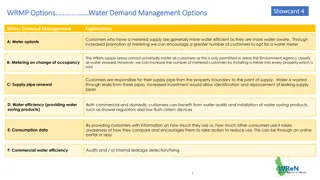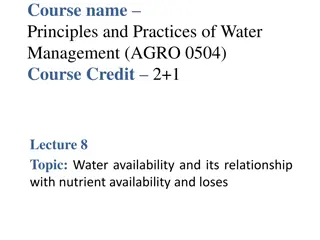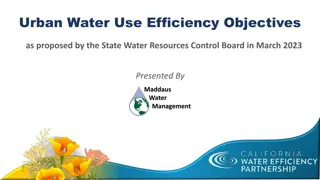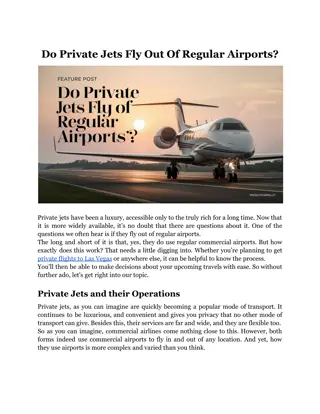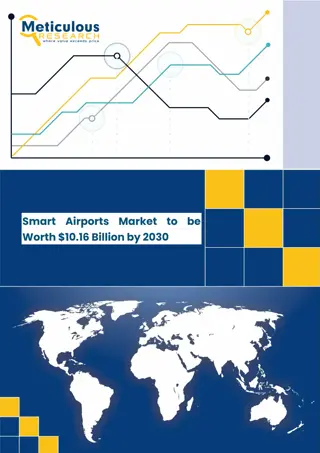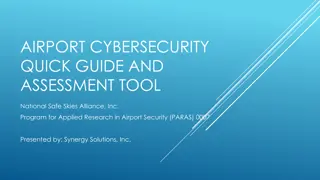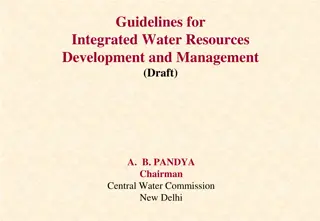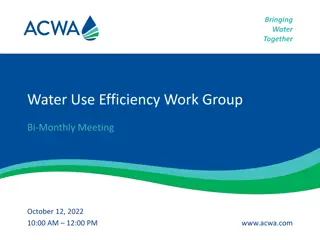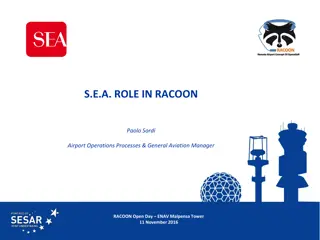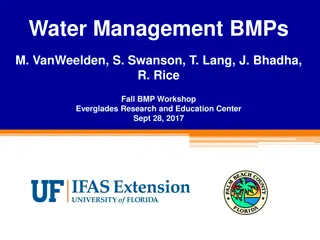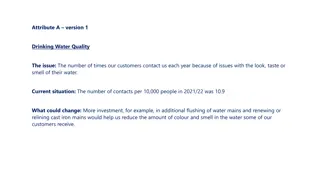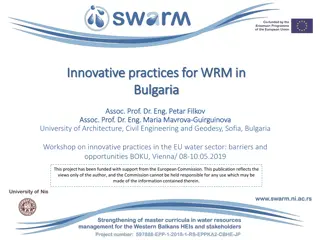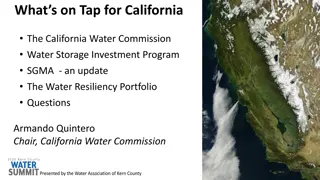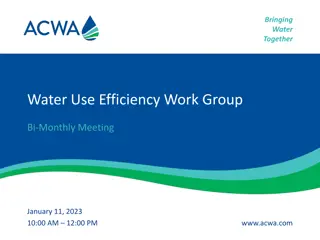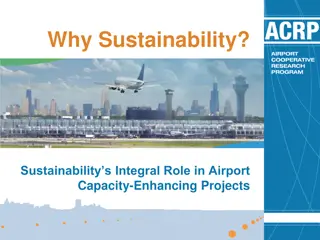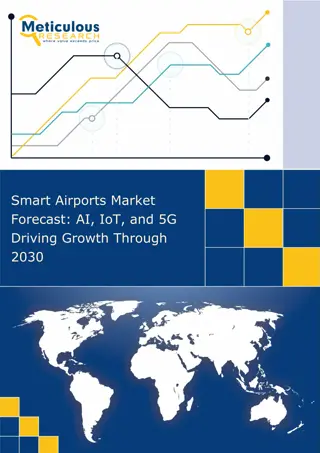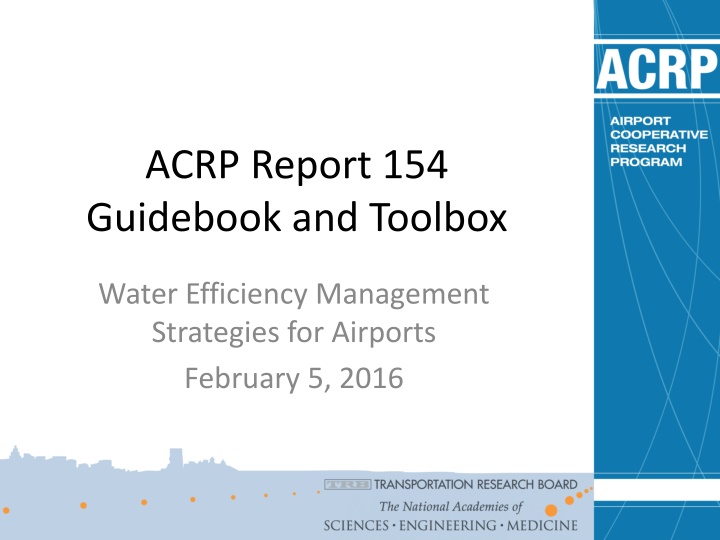
Water Efficiency Management Strategies for Airports
Water efficiency is crucial for airports due to increasing water demands, climate changes, and regulations. This guidebook provides solutions to address water efficiency, tools to manage programs, and detailed instructions for implementing programs to lower costs and enhance sustainability.
Download Presentation

Please find below an Image/Link to download the presentation.
The content on the website is provided AS IS for your information and personal use only. It may not be sold, licensed, or shared on other websites without obtaining consent from the author. If you encounter any issues during the download, it is possible that the publisher has removed the file from their server.
You are allowed to download the files provided on this website for personal or commercial use, subject to the condition that they are used lawfully. All files are the property of their respective owners.
The content on the website is provided AS IS for your information and personal use only. It may not be sold, licensed, or shared on other websites without obtaining consent from the author.
E N D
Presentation Transcript
ACRP Report 154 Guidebook and Toolbox Water Efficiency Management Strategies for Airports February 5, 2016
Why Is Water Efficiency Important? Water resources are being squeezed: Demand continues to grow for clean and safe water from increasingly stressed water resources. Climatic changes increase the probability of variations in water availability from year to year. Increasingly complex regulations affect both the availability and cost of potable water. As major consumers of water, airports have an obligation to be responsible environmental stewards in the community by increasing the efficiency of their water use. Increased water efficiency can lower airports costs and improve the financial as well as the environmental sustainability of their operations.
How to Address Water Efficiency at Airports? Solution: TRB created resources to help airports manage water efficiency programs: A Guidebook to help airports design, implement, evaluate, and maintain a water efficiency management program. A Toolbox of 34 tools used by airports and other facilities to support water efficiency programs. A spreadsheet-based End Use Water Audit Tool to help airports develop a water use baseline and water efficiency targets.
OVERVIEW OF THE GUIDEBOOK
The Guidebook Provides Detailed Instructions and Examples from the Real World Each chapter explains how to carry out each step in developing and implementing a water efficiency program. The Guidebook show how tools being used by airports and other facilities can be used to help develop and implement water efficiency programs at airports. The Guidebook provide examples of issues and challenges airports may face and potential solutions.
The Guidebook Walks Facility Managers through the Steps Required to Establish a Program Chapter 1: Why Should an Airport Reduce its Water Usage? Chapter 2: Generating a Water Footprint Baseline. Chapter 3: Defining Targets. Chapter 4: Evaluating and Choosing Water Efficiency Measures and Strategies. Chapter 5: How to Design a Program. Chapter 6: Implementing the Water Efficiency Program. Chapter 7: Maintaining, Evaluating, and Revising the Water Efficiency Program.
Chapter 1: Why Should an Airport Reduce its Water Usage? Describes the potential value of water efficiency programs for airports. Explains how airports can reduce water use by: Fixing leaks and reducing water loss. Replacing high water use fixtures, equipment, and systems with more water-efficient options. Educating employees and occupants about water efficiency to encourage water-saving behaviors. Discusses the role water efficiency measures can play in planning responses to droughts.
Chapter 2: Generating a Water Footprint Baseline The water footprint tells us: How much water is being used, Where water is being used, and How water is being used. This chapter describes how airports can generate an estimate of their water use and establish a water footprint baseline. The End Use Water Audit Tool is introduced in this chapter. The chapter explains how the Tool can be used to estimate water use by end-use throughout the airport. The chapter discusses some of the challenges airports may face when the establish the baseline and offers potential solutions.
Chapter 3: Defining Targets The chapter describes how the End Use Water Audit Tool can be used to identify ways to save water. Using the baseline, the chapter explains how to establish water efficiency targets. Water efficiency measures include: Airports can upgrade the water fixtures in restrooms, kitchens, and other facilities. Airports can install water-efficient irrigation systems for landscape irrigation. Airports can reconfigure or redesign operations to reduce water use in some areas. Airports can institute change campaigns to modify water use behaviors. Examples of ways to save water are provided for: Landscaping, Cooling towers, Construction, Deicing and Anti-icing, and Water reuse.
Chapter 4: Evaluating and Choosing Water Efficiency Measures and Strategies This chapter discusses how to choose which water efficiency measures to implement and how to develop an implementation strategy. It describes the screening process used to identify measures that can be implemented. It provides an overview of how cost- benefit analyses can identify cost-effective measures for improving water efficiency.
Calculating the Effect of Water Efficiency Programs on the Bottom Line Chapter 4 describes the basic steps of a cost-benefit analysis. Identify and measure the costs of the water efficiency program. Identify and measure the benefits of the water efficiency program. Discount future costs and benefits. Calculate the impact of the water efficiency program on the bottom line. It recommends several measures that can be used to evaluate water efficiency programs: Net present value Benefit cost ratios Cost per gallon of water saved Payback period
Chapter 5: How to Design a Program This chapter explains how to design a water efficiency program. It emphasizes the importance of involving management, employees, and other stakeholders early in the process. Steps include: Convening a water efficiency management team Preparing an action plan Considering financial resources Educating employees and tenants
Chapter 6: Implementing the Water Efficiency Program This chapter explains how the implementation strategy can increase the success of the program and can help airports achieve their water efficiency management goals. Designing a successful strategy includes the following steps: Assess Water Efficiency Priorities Determine Resource Adequacy Develop Implementation Schedule Employee training will help ensure the effective implementation of the program. Communication strategies that will guide outreach efforts to support the implementation of the program are described.
The Steps to Develop a Successful Communication Strategy Include Step 1. Develop a Mission Statement Step 2. Brainstorm Communication Channels Step 3. Develop a Communication Plan Step 4. Brand the Program Step 5. Craft the Messaging Step 6. Package and Distribute
Chapter 7: Maintaining, Evaluating, and Revising the Water Efficiency Program This chapter explains how the water efficiency management team should periodically conduct a formal review of water end use data and action plan and determine if it is achieving the established goals. Reviews should include: A review of water bills and meter and submeter readings to verify that the expected water savings are achieved. A review of the action plan, at least on an annual basis, and revise water management goals as they are achieved. A detailed reassessment of the program every 4 years.
The Report Provides a Toolbox Airports Can Use to Implement Water Efficiency Programs The Guidebook shows how the tools can be used to design and implement water efficiency programs. The tools include the spreadsheet-based End Use Water Audit Tool, and a detailed user s guide is included with the report. The Toolbox includes other tools used at airports and other facilities to improve water efficiency.
The Toolbox Contains 34 Tools to Design and Implement Airport Water Efficiency Programs Tool 1: ACRP End Use Water Audit Tool Tool 2: WaterSense Commercial Buildings Website Tool 3: Best Management Practices for Industrial Water Users Tool 4: Water Efficiency Manual for Commercial, Industrial, and Institutional Facilities Tool 5: Facility Manager s Guide to Water Management Tool 6: Water Efficiency and Self-Conducted Water Audits at Commercial and Institutional Facilities: A Guide for Facility Managers (Second Edition)
The Toolbox Contains 34 Tools to Design and Implement Airport Water Efficiency Programs Tool 7: EDF-GEMI WaterMAPP Tool 8: Water and Energy Efficiency Program for Commercial, Industrial, and Institutional Customer Classes in Southern California Tool 9: Federal Water Efficiency Best Management Practices Tool 10: Water Efficiency Opportunities Airports Best Practice Guide Tool 11: Guidebook for Incorporating Sustainability into Traditional Airport Projects Tool 12: Sustainable Airport Planning, Design and Construction Guidelines for Implementation on All Airport Projects
The Toolbox Contains 35 Tools to Design and Implement Airport Water Efficiency Programs Tool 13: AWWA Water Loss Control Committee's Free Water Audit Software Tool 14: Alliance for Water Efficiency Resource Library Tool 15: WaterSense Smart Outdoor Practices Tool 16: COOL TUNES: Run an Efficient Cooling Tower (v 1.0) Water Smart Technology Program Tool 17: Cooling Towers: Understanding Key Components of Cooling Towers and How to Improve Water Efficiency Tool 18: Increasing Cooling Tower Water Efficiency Tool 19: WaterSense Rebates Finder
The Toolbox Contains 35 Tools to Design and Implement Airport Water Efficiency Programs Tool 20: Database of State Incentives for Renewables and Efficiency Tool 21: A Comprehensive Guide to Water Conservation: The Bottom Line Impacts, Challenges, and Rewards Tool 22: Getting in Step: A Guide for Conducting Watershed Outreach Campaigns Tool 23: Getting in Step: Engaging and Involving Stakeholders in Your Watershed Tool 24: M52 Water Conservation Programs A Planning Manual (First Edition)
The Toolbox Contains 34 Tools to Design and Implement Airport Water Efficiency Programs Tool 25:Water Resources in the Phoenix Metro Area Tool 26:Sustainable Water Management, Northwest Perspective, Seattle-Tacoma International Airport Tool 27:Great Lakes / St. Lawrence River Water Conservation Model Policies & Measures Tool 28:Survival Guide: Public Communications for Water Professionals Tool 29:A Water Conservation Guide for Commercial, Institutional, and Industrial Users
The Toolbox Contains 35 Tools to Design and Implement Airport Water Efficiency Programs Tool 30:2012 Guidelines for Water Reuse Tool 31:RS Means Construction Cost Indices Tool 32:Guidelines for Estimating Unmetered Landscaping Water Use Tool 34:National Integrated Drought Information System Tool 35:Benefit-Cost Analysis for the Airport Improvement Program Airports
The End Use Water Audit Tool Establishes Water Use Baselines and Efficiency Targets Helps airports assess water use by end use and establish a water use baseline. The tool is flexible: Run it with minimum data and get an initial snapshot of an airports baseline. Enter airport-specific information about end uses to get a more complete picture of an airport s water use. Estimates can be calibrated to actual metered data. The tool shows where water is used now and predicts potential water savings. Multiple versions can be used to track changes over time or to compare alternative baselines.
Data Requirements The more data you have and enter, the more accurate your results. But There are diminishing returns some shortcuts will work fine. Airports may not have the detailed data or the time to enter them into the tool. Metering water use at end uses is not feasible.
The Tool Uses Airport-Specific Information and General Assumptions to Estimate Water Use by End Use It uses information about flights, passengers, buildings and their sizes. It has default values on fixture flow rates, landscape water use, cooling towers, and other water uses. The default values can be revised as needed to use specific airport values. The user s guide explains each step involved in using the Tool: Data entry Reviewing initial results Calibrating and verifying the Tool s estimates Summarizing results
The Tool Summarizes Airport Water Use and Potential Savings in Tables Summary Table 5. Water Use by End Use Water Use Ratio 1.26 8.03 2.01 2.64 1.56 2.82 3.46 2.00 1.50 1.67 1.50 1.20 22.89 1.33 1.50 1.50 1.50 1.50 1.50 1.50 1.50 2.00 1.51 5.42 Use GPD %Total Use Optimal GPD Savings GPD %Savings Toilets Urinals Faucets Kitchen faucets Pre-rinse spray valves Dishwashers Ice machines Showers Swimming pool Laundry Boiler Cooling Outdoor irrigation Vehicle washing Pavement cleaning Training Snow removal Fleet vehicle washing Runway rubber removal Aircraft cleaning Onboard aircraft water Deicing Other TOTAL 5,899,923 101,081 7,587,633 516,707 192,163 86,100 66,200 1,608 7,075 12,575 1,206 150,000 15,075 6.8% 2.5% 1.1% 0.9% 0.0% 0.1% 0.2% 0.0% 2.0% 0.2% 0.0% 6.9% 77.8% 1.3% 0.1% 0.0% 0.0% 0.0% 0.0% 0.0% 0.0% 0.0% 0.0% 100% 100,000 438,481 257,803 75,811 1,398,936 410,622 23,924 42,811 25,100 1,029 2,510 3,636 5,642,120 25,270 6,188,697 106,085 168,239 43,289 41,100 20.5% 87.6% 50.3% 62.1% 36.0% 64.5% 71.1% 50.0% 33.3% 40.0% 33.3% 16.7% 95.6% 25.0% 33.3% 33.3% 33.3% 33.3% 33.3% 33.3% 33.3% 50.0% 33.6% 81.6% 579 4,565 8,939 603 50,000 6,030 603 9,045 113 75 38 526,177 87,696 4,150 2,766 1,383 15 750 10 500 5 250 500 500 300 300 800 106 1,500 1,500 900 900 1,600 316 1,000 1,000 600 600 800 210
and in Simple, Customizable Graphics Water Use by Facility Group Terminals Office Buildings Rental Car Center Ground Transportation Parking Fire and Police Stations Hotels
The Research to Develop the Guidebook and Toolbox was Conducted in 4 Phases 1.Identify data gaps. 2.Fill the gaps. 3.Develop Guidebook and Toolbox. 4.Test and Finalize the Guidebook and Toolbox.
The First Phase of the Study Conducted a literature and data review. Identified gaps in information. Built the beta version of the end use water audit tool. Created an outline of the Guidebook and an example draft chapter. Recruited airports to participate in the pilot test and interviews.
The Second Phase of the Study Conducted a pilot test of the Tool at 6 airports. Interviewed airport facility managers and staff at 15 airports about: Water efficiency management programs. Airport operations. Challenges and obstacles of water conservation. Tools and other materials that airports use to promote water efficiency.
The Third Phase of the Study Developed a draft of the Guidebook. Developed an initial version of the Toolbox. Revised the End Use Water Audit Tool based on the results of the pilot tests.
The Fourth Phase of the Study Four airport environmental managers tested the Guidebook and Toolbox, including the End Use Water Audit Tool Drafted the final deliverables.
The Study Used the Pilot Tests and Interviews to Test the Tools and Collect Information A list of potential participants for the pilot test and interviews was developed. Interview topics covered include: Airport infrastructure. Airport organization. Airport water resources. Airport water efficiency management programs and practices. Airport challenges and restrictions.
Airports were Selected from Multiple Climate Zones, Precipitation Zones, and FAA Regions
The Tool was Tested at Six Airports 2013 Airport SMO Facility Name Santa Monica Municipal Type General Aviation Primary Nonhub Primary Small Enplanements FAA Region 3,529 Climate Zone Mixed-Dry/Hot- Dry Mixed-Humid Western- Pacific Southern PAH Barkley Regional 20,523 MHT Manchester-Boston Regional Atlanta Hartsfield- Jackson International Minneapolis-St Paul International Phoenix Sky Harbor International 1,190,082 New England Very Cold/Cold ATL Primary Large 45,308,685 Southern Hot-Humid MSP Primary Large 16,282,038 Great Lakes Very Cold/Cold PHX Primary Large 19,525,829 Western- Pacific Mixed-Dry/Hot- Dry
Interviews were Conducted at the Six Pilot Test Airports, Plus Nine Additional Airports 2013 Airport VCT Facility Name Victoria Regional Type Enplanements 3,288 FAA Region Southwest Climate Zone Hot-Humid Nonprimary Commercial Service Primary nonhub PHF Newport News/Williamsburg International Southwest Oregon Regional 264,279 Eastern Mixed-Humid OTH Primary nonhub 16,864 Northwest Mountain Southwest Marine TUL Tulsa International Primary small 1,323,943 Mixed-Humid ELP El Paso International Primary small 1,363,258 Southwest Mixed-Dry/Hot-Dry AUS Austin-Bergstrom International Providence T. F. Green Airport Raleigh-Durham International San Francisco International Primary medium 4,902,080 Southwest Hot-Humid PVD Primary medium 1,885,232 New England Very Cold/Cold RDU Primary medium 4,482,973 Southern Mixed-Humid SFO Primary large 21,706,567 Western- Pacific Marine
The Guidebook and Toolbox were Ground Tested by Environmental Managers at 4 Airports 1.Dallas/Fort Worth International Airport. 2.San Diego County Regional Airport Authority. 3.San Francisco International Airport. 4.Aviation Division of the Port Authority of New York and New Jersey.
The products created by ACRP 02-59 will help airports design, implement, evaluate, and maintain a water efficiency management program, including developing water use baselines and water efficiency targets
Water Efficiency Management Strategies for Airports Thanks! Richard A. Krop, Ph.D., Principal Investigator The Cadmus Group, Inc.

